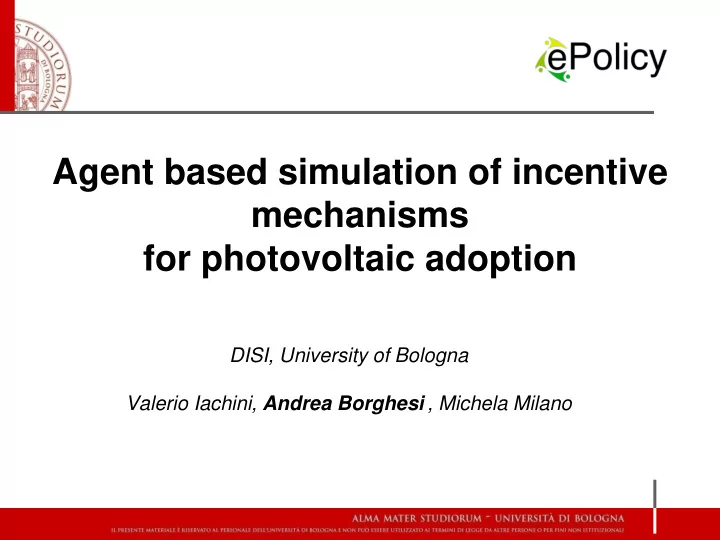

Agent based simulation of incentive mechanisms for photovoltaic adoption DISI, University of Bologna Valerio Iachini, Andrea Borghesi , Michela Milano
Context • Sustainable energy policies – Complex issues: rapidly changing environments, conflicts among different interests.. – Strong impact on economic development sustainability and social acceptance • ePolicy European project – Aim: provide decision support systems for policy makers – Case study: Emilia-Romagna regional Energy Plan
The Problem • Policy makers can use several instruments to foster the transition towards renewable energies – Feed-in tariffs, tax exemptions, fiscal incentives, grants, etc. • Focus: photovoltaic (PV) energy • We must evaluate the impact of such incentives – Each instrument has a cost – The PV plants (panels) are installed by citizens and enterprises no direct government bodies actions – We need to understand the social reaction to policy instruments
Proposed Approach (1) • We are dealing with a complex problem • To aid policy makers to evaluate the best implementation policy we propose an agent-based model • Two main goals: 1. Model the diffusion of residential PV systems 2. Assess the impact of the incentives • We simulate the behaviour of single households and government entities ( micro -level) to study and understand emergent phenomena ( macro- level)
Proposed Approach (2) • We consider several factors: – Economic aspects (Return On Investment, family income, etc.) – Geophysical aspects (position, roof available, etc.) – Social aspects (imitation, network effect, etc.) • Consequently we must calibrate several parameters (the social ones in particular) we employ automatic parameters tuning techniques – Comparison with past data from Emilia-Romagna Region to check the validity of our results
Results • Real VS simulated trends in PV power installation (ER)
Conclusion • We proposed an agent-based model to simulate the diffusion of PV systems • Model fine tuned using past data • Good Results – It’s probably still possible to reduce the margin of error • Future research directions: – Test new calibration methods – Test with different datasets – Scale-up the number of agents in the model
That’s all Thanks! andrea.borghesi3@unibo.it
Recommend
More recommend